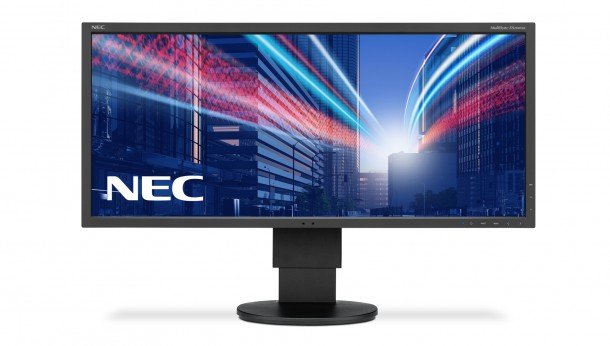Ultra-widescreen: can 21:9 be a new standard for gaming?

Do you long for a monitor that eclipses your entire peripheral vision, or is the dominant 16:9 ratio quite wide enough? Manufacturers like NEC, LG and Phillips are giving us the choice with ultra-widescreen 21:9 monitors like the one above. This super-wide, 2560x1080 resolution gives one hell of an increased field of view, but is it something we really want to put our graphics cards through?
The world of the PC monitor has been a strange old place over the last few years. We were all very happy with 16:10 widescreen monitors, then the consoles came along and suddenly everyone wanted the HD res of 1080p. Almost overnight we lost our screen space. The vertical resolution of our 1900x1200 PC monitors were chopped down to just 1080 lines.
Along with the smaller 16:10 monitors went the chunky 30-inch panels - with their 2560x1600 resolution - so then we had to make do with 27-inch screens at 2560x1440. Now that desktop real estate is getting another chop with these freakish screens from Philips and NEC.
To be fair there is some merit in such a widescreen res, and that's mostly for movies in cinema aspect ratios. That said, Philips discontinued its 21:9 television range last year due to low demand. I can't really see the demand for 2560x1080 screens being there in the PC market either.

Admittedly, these shots look great. In-game, ultra-widescreen works pretty well, adding extra cinematic flavour to first and third-person games, though my obsession with Football Manager isn't going to benefit at all from a 21:9 resolution, and these super-wide panels are no match for a good multi-monitor setup.
I've used multi-screen displays to create a wraparound image in-game for some work I've been doing recently, using stereo drivers from both AMD and Nvidia. The extra width that offers gives you peripheral vision for FPS games and an extra sensation of speed in driving titles too. These 21:9 screens simply don't offer the same benefits. The image is flat in front of you so there is none of the positives from the wraparound peripheral images, and you'll still suffer from lower frame rates as the extra resolution width makes greater demands on your hardware.

When you do finally leave your game and try to do anything on the desktop you'll immediately miss that vertical space. I'd still rather have the extra height of a 16:10 or 16:9 screen. These 21:9 options just look like they're missing a huge chunk of panel from the mix, and they're pricey, too. The new NEC MultiSync EA294WMi retails for just under £500 and the Philips Brilliance UltraWide hitting the shelves at around £400 in the UK.
Keep up to date with the most important stories and the best deals, as picked by the PC Gamer team.
Maybe I'm behind the times here - what do you think? Is there a place for super-widescreen monitors in PC gaming?

Dave has been gaming since the days of Zaxxon and Lady Bug on the Colecovision, and code books for the Commodore Vic 20 (Death Race 2000!). He built his first gaming PC at the tender age of 16, and finally finished bug-fixing the Cyrix-based system around a year later. When he dropped it out of the window. He first started writing for Official PlayStation Magazine and Xbox World many decades ago, then moved onto PC Format full-time, then PC Gamer, TechRadar, and T3 among others. Now he's back, writing about the nightmarish graphics card market, CPUs with more cores than sense, gaming laptops hotter than the sun, and SSDs more capacious than a Cybertruck.

